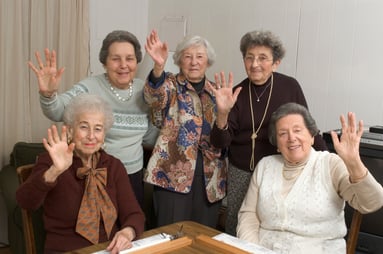I was scrolling through my Twitter feed recently and stumbled across a posting for a Life Enrichment Director with a prominent senior living provider. The title was intriguing enough—I’m always curious about what’s happening in the area of wellness and lifestyle in senior living—so I clicked on the link, taking me to the job posting. What I read on the posting was enough to make me hang my head.
 Without getting into detail, I’ll tell you that a primary responsibility for the position was to “create pleasant days.” Now, that requirement was in quotes on the posting, which makes me think it’s a branded program that’s a hallmark for the organization. And to be clear, the posting was for a Life Enrichment Director in a memory care community. So I can appreciate the need for programming to minimize participants’ agitation and anxiety, and to maximize the enjoyment of their days. Still, the idea of programming around building pleasant days for residents (in any level of care) struck me as wildly patronizing and profoundly off base.
Without getting into detail, I’ll tell you that a primary responsibility for the position was to “create pleasant days.” Now, that requirement was in quotes on the posting, which makes me think it’s a branded program that’s a hallmark for the organization. And to be clear, the posting was for a Life Enrichment Director in a memory care community. So I can appreciate the need for programming to minimize participants’ agitation and anxiety, and to maximize the enjoyment of their days. Still, the idea of programming around building pleasant days for residents (in any level of care) struck me as wildly patronizing and profoundly off base.
Folks, we are doing an enormous disservice to the adults in our communities (in any area of the community) if our primary focus is to make their days nice. The residents are living, not passing life by sitting in a rocking chair on your porch. Your Life Enrichment Director shouldn’t be facilitating passive and placating activities unless that’s what the participant wants.
The Need for More Engaging Senior Living Activities and Programs
Most of the amazing older adults I’ve met as I’ve traveled to various communities are full of life, eager to connect, and interested in learning new things. We have got to do lifestyle programming better than building pleasant lives for them. To be fair, a lot of organizations are succeeding at implementing creative, active, and engaging programs for their members. For example, Mather Lifeway’s café concept provides for fabulous connections with peers in the midst of unique and lively programs.
However, in many cases, what I see in communities is a calendar full of activities where 90 percent of what’s listed are recurring events like cards, exercise classes, arts/crafts groups, religious services, shopping trips, and coffee or happy hours. The remaining 10 percent are unique to the month and are typically grouped into musical offerings, lectures, and excursions to the theatre or opera. From a maintaining status quo standpoint, there is nothing wrong with that calendar. Just don’t confuse it with one that is built to engage more than the 20 percent of your residents who participate in existing programs. And don’t consider that calendar creative and interesting simply because there’s no white space left to pack in more activities.
Building a Better Activities Calendar
If you’re interested in building a better activities (or life enrichment, or wellness…) calendar and program, here are some starting points for consideration:
- Evaluate what needs to change about your current mentality on programming for your members. If your job is to provide lots of opportunities to keep residents busy, it’s time to rethink the job. Residents don’t want to be kept busy; toddlers need to be kept busy. Building a successful and person-centered programming schedule is about inviting residents to engage in the lifestyle they want—the lifestyle that’s driven by their passions and interests.
- Ask what success looks like for any given program. (Hint: the answer is quantifiable and isn’t measured by how satisfied the residents look.) Then establish your programming goals and figure out how to measure them. Take what you learn from that evaluation and do better with the next program.
- Understand what drives your residents, and keep track of that information. Ask them what they’re passionate about and what makes them get out of bed in the morning. If you don’t have programming that speaks to those interests, figure out how to support them anyway (for example, see how one community supported an interest in golf). When you have an inventory on all the members, you have a tool to inform what types of programs you should start building and which residents you need to tap to be champions for the newest offering.
It’s time to stop busying yourself and your residents with filled-to-the-brim calendars that lack intention and invitation. Start actually building Life Enrichment by getting to know what motivates your members and build your creative and strategic (and dare I say “edgy”) program around your people, not their pleasant days.
Ready to get started? Click below to find out how we can help you.

